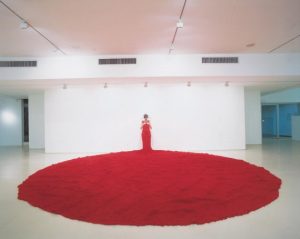Unmasking the wild, unexpected faces of contemporary Israeli arts
April 24th, 2017
Yair Dalal plays blues-inspired Iraqi tunes on the oud. Ibrahim Miari whirls like a Sufi dervish while wearing a gas mask from the Gulf War.
Raafat Hattab lip-syncs as his alter ego, the Bride of Palestine; Elad Schechter’s dancers throw bananas at their audiences in Jerusalem’s Mahane Yehuda market; and Iris Zaki films herself washing Arab and Jewish women’s hair in a Haifa salon.
This is the face of Israeli culture today, as expressed by a group of Jewish and Muslim artists, musicians, dancers and filmmakers brought to the East Bay this week for a three-day conference hosted by the Berkeley Institute for Jewish Law and Israel Studies.
The April 5-7 conference, which featured panel discussions as well as performances, examined how the arts express and influence critical topics in Israeli society today — faith, sexuality, politics and technology — while breaking down barriers between cultural and religious groups, celebrating an Israeli identity that is as multi-faceted as the country’s people.
“For many years, there was a focus on creating a collective idea of what Israeli art is,” said Sharon Aronson Lehavi, a professor of theater and performance studies at Tel Aviv University who spoke on one of the panels. “One of the things that is happening is an unmasking of hegemony within Israeli culture.”

Dalal, a master of the oud and the violin whose performances highlight his Iraqi-Jewish heritage as well as his interest in jazz, blues and other music styles, says the days of cultural assimilation in Israel are over.
“When we grew up in Israel, everyone told us [we had] to be part of the melting pot,” he said. “But then you realize this melting pot doesn’t have any taste because it has no roots.
“It took years to break this melting pot. Now in Israel, everyone is trying to connect to his own culture that we left behind. This generation, they do it without any fear. When we did it, there was a lot of fear about what they would think of us. Nowadays, no one is afraid any more, and I think it’s because of something that has changed in the culture of Israeli society.”
Artists at the conference say they and their peers don’t hesitate to emphasize issues of gender or national identity, allowing them to create new artistic collaborations such as between Palestinian Arabs and Israeli Jews.
Miari, born in Acco to a Jewish Israeli mother and Palestinian Muslim father, not only illustrates that collaboration in his own biology, but makes it the focus of his autobiographical one-man theater piece.
“As a child, I thought everyone grew up with two cultures,” he told the audience after his April 6 performance. “Only later, when people began to ask me who I am, did I have to find my own identity. Theater helped me do that.”
One panel focused on Israeli artists grappling with questions of religion, gender and sexuality. Several talked about their use of the human body in light of their faith’s modesty traditions.
Schechter’s Jerusalem-based dance troupe performs in the open-air Machane Yehuda market, as well as other neighborhoods including the ultra-religious Mea Shearim, using energetic, often provocative movements to explore the importance of touch — literal and figurative — in human relationships.
“In Judaism there’s the idea of shomer negiah, that you’re not supposed to touch women,” he said, noting that his dance pieces try to subvert that paradigm. “We try to bring body culture into the public space and create opportunities for different communities to ‘touch’ each other.”
Hattab, an openly gay Muslim artist who rejected Islam in his teens, said that in his 30s, he made peace with it through his art. For a period of time, he said, he was “an obsessive knitter,” creating textile art with the craft.
“In Islam, like Judaism, the human figure is not allowed,” he explained. “There’s this notion of endless, empty space, which is God. When I knit, there’s an endless pattern; it refers to the Islamic idea of God that has no beginning and no end.”
For all of these artists, using their art to connect people is a key theme.
Textile and performance artist Nelly Agassi described how she stood inside the Tate Modern in London one afternoon and gave away 800 white tee-shirts she had made, each with the words “I am the one” written — in white letters — on the front. People took the shirts and put them on right in front of each other, laughing and talking, connecting in a more intimate way than might be expected of museum-goers.
“There I was, looking at all these little white-on-white dots milling around the museum,” she recalled. “They were all ‘the one.’ It’s important for everyone to feel that they are the one. You have to be for yourself first, before you can be for your lover, your family.”
While the artists featured at this conference borrowed from cultures and communities not their own, their art is successful, said Dalal, when they are grounded in their own first.
“You have to start with your own tradition,” he said. “There’s an Arabic phrase that says, ‘Without the old you cannot create the new.’”
Source: “Unmasking the wild, unexpected faces of contemporary Israeli arts,” J Weekly, April 7, 2017